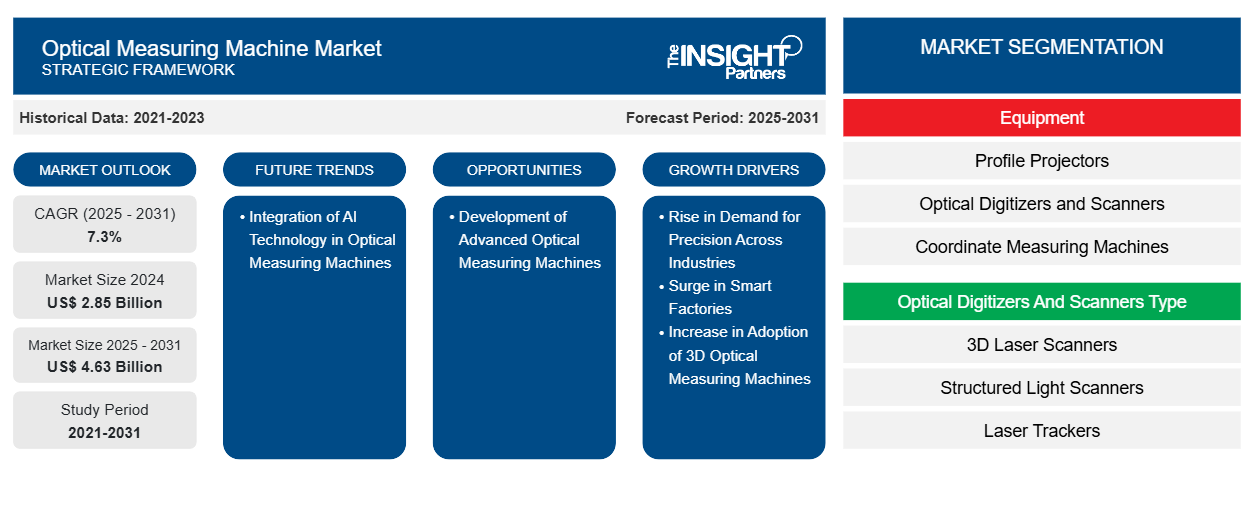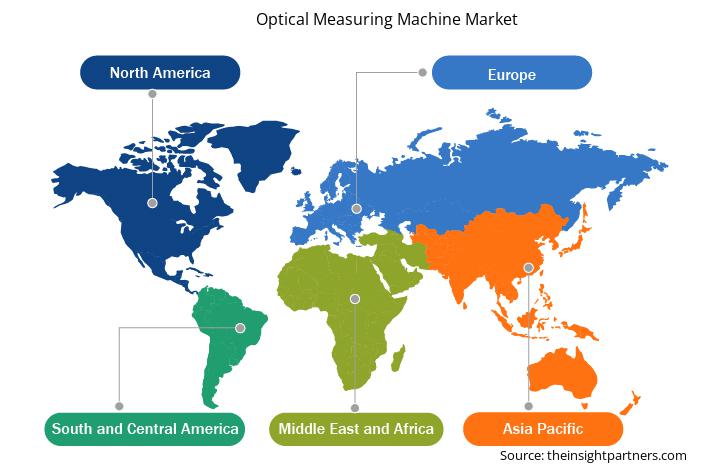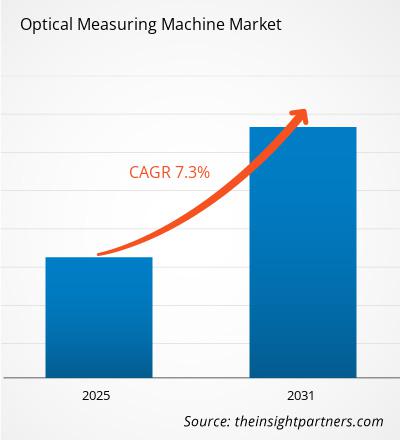광학 측정기 시장 규모는 2024년 28억 5천만 달러로 평가되었으며, 2031년에는 46억 3천만 달러에 이를 것으로 예상됩니다. 2025년부터 2031년까지 연평균 성장률(CAGR)은 7.3%에 이를 것으로 예상됩니다. 개방적이고 상호 운용 가능한 표준 채택 증가는 새로운 광학 측정기 시장 트렌드를 가져올 것으로 예상됩니다.
광학 측정기 시장 분석
산업 확장과 산업 전반의 정밀성 수요 증가, 그리고 스마트 팩토리의 급증은 광학 측정기 수요를 견인하고 있습니다. 산업 전반의 생산량 증가와 3D 광학 측정기 사용 증가는 시장 성장을 촉진하고 있습니다. 기술 발전과 제조업체들의 첨단 광학 측정기 개발에 대한 집중은 예측 기간 동안 시장에서 수익성 있는 기회를 창출할 것으로 예상됩니다. 또한, 급증하는 연구 개발 활동, 광학 측정기에 AI 기술 통합, 그리고 차세대 광학 측정기의 발전은 향후 몇 년간 광학 측정기 시장의 성장 기회를 창출할 것으로 예상됩니다.
광학 측정기 시장 개요
광학 측정기는 광 센서, 카메라, 레이저를 사용하여 물체의 물리적 치수를 측정하는 첨단 장비입니다. 광학 측정의 주요 장점은 물체와 직접 접촉할 필요가 없어 물체의 무결성을 유지하고 산업계에서 깨지기 쉽거나 복잡한 부품을 측정할 수 있다는 것입니다. 이러한 비침습적 접근 방식은 섬세한 부품을 보호하고 마이크론 단위의 높은 반복성과 정확도를 보장합니다. 이러한 기계는 일반적으로 고해상도 카메라나 센서를 사용하여 사진을 촬영합니다. 그런 다음 소프트웨어가 이미지를 분석하여 길이, 너비, 높이, 각도, 표면 특성과 같은 정확한 치수 데이터를 추출합니다. 광학 측정기는 검사, 품질 관리, 역설계, 설계 검증 등에 유용합니다. 산업이 더욱 엄격한 공차를 가진 부품 및 장치의 소형화로 전환함에 따라 광학 측정기의 도입이 증가하고 있습니다. 항공우주, 자동차, 의료기기, 전자 등 여러 산업에서 제품 품질 유지 및 표준 준수를 위해 프로파일 프로젝터, 광학 디지타이저 및 스캐너, 측정 현미경, 비디오 측정기, 프로파일로미터와 같은 다양한 기계를 적극적으로 도입하고 있습니다.
이 보고서의 일부 또는 국가 수준 분석, Excel 데이터 팩을 포함하여 모든 보고서에 대한 사용자 정의를 무료로 받을 수 있으며, 신생 기업 및 대학을 위한 훌륭한 혜택과 할인도 이용할 수 있습니다.
광학 측정기 시장: 전략적 통찰력

-
이 보고서에서 주요 시장 동향을 알아보세요.이 무료 샘플에는 시장 동향부터 추정치 및 예측까지 다양한 데이터 분석이 포함됩니다.
광학 측정기 시장 동인 및 기회
산업 전반의 정밀성에 대한 수요 증가
산업 분야 전반에 걸쳐 정확성과 정밀성에 대한 지속적인 수요는 실시간 모니터링 및 공정 제어를 위한 광학 측정기 도입을 촉진했습니다. 이는 시장 참여자들이 다양한 산업 분야의 고객을 유치하기 위해 제품 인지도를 높이는 데 기여했습니다. 예를 들어, 2025년 4월, JENOPTIK AG는 2025년 5월 6일부터 9일까지 슈투트가르트에서 개최되는 Control 무역 박람회에서 포괄적인 측정 포트폴리오를 선보였습니다. 이 포트폴리오에는 HOMMEL ETAMIC(산업용 고정밀 측정 제품 및 솔루션), TRIOPTICS(광학 샤프트 측정 및 비접촉 광학 측정기용 Opticline CS 시리즈), 그리고 SwissOptic(광학 측정 기술 및 시스템) 등 다양한 브랜드의 제품이 포함되어 있습니다. 따라서 시장 참여자들은 광학 측정기 사용의 중요성에 대한 인지도 제고, 고성능 기계에 대한 수요, 그리고 정확성과 정밀성에 대한 산업적 수요 증가에 집중하며 광학 측정기 시장 성장을 견인하고 있습니다.
스마트 팩토리의 급증
스마트 팩토리에 실시간 데이터 분석과 머신러닝(ML) 알고리즘을 통합하려면 공정 변경을 위한 신속한 피드백을 제공하는 광학 측정기의 도입이 필수적입니다. 디지털 플랫폼과 쉽게 통합되는 광학 측정기는 산업의 연속 모니터링 및 폐쇄 루프 제조 시스템에 도움을 줍니다. 이러한 실시간 기능은 제품 품질을 향상시키고, 낭비를 최소화하며, 예측 유지보수를 가능하게 합니다. 비디오 측정기(VMM), 광학 디지타이저 및 스캐너(ODSS), 좌표 측정기(CMM), 측정 현미경과 같은 광학 측정기는 물리적 접촉 없이 복잡한 형상과 표면을 비침투적이고 빠르고 매우 정확하게 평가할 수 있도록 합니다. 이를 통해 마모를 줄이고, 복잡한 부품 손상 위험을 줄이며, 사이클 시간을 단축할 수 있습니다. 정확성, 정밀성, 속도 및 자동화를 중시하는 스마트 팩토리가 성장함에 따라 산업 전반에서 광학 측정기에 대한 수요가 증가하고 있습니다. 항공우주, 자동차, 전자, 반도체, 의료 산업은 품질 보증 및 공정 최적화를 위해 광학 측정기를 점점 더 많이 도입하고 있습니다. 일관되고 비접촉식이며 실시간 측정을 제공하는 광학 측정기는 새로운 디지털 제조 생태계에서 필수적인 도구입니다.
광학 측정기 시장 보고서 세분화 분석
광학 측정기 시장 분석에 기여한 주요 부문은 장비, 산업 분야, 유형, 응용 분야 및 지역입니다.
- 장비별로 보면, 글로벌 광학 측정기 시장은 프로파일 프로젝터, 광학 디지타이저 및 스캐너(ODSS), 좌표 측정기(CMM), 측정 현미경, 비디오 측정기(VMM)/비전 측정 시스템, 프로파일로미터 등으로 세분화됩니다. 좌표 측정기(CMM) 부문은 2024년 광학 측정기 시장 점유율 1위를 차지했습니다. 광학 디지타이저 및 스캐너(ODSS) 부문은 3D 레이저 스캐너, 구조광 스캐너, 레이저 트래커로 세분화됩니다.
- 광학 측정기 시장은 용도별로 직선(프리즘) 부품과 선삭 부품으로 구분됩니다. 직선(프리즘) 부품은 2024년에 광학 측정기 시장 점유율이 가장 높았습니다. 선삭 부품 부문은 샤프트, 부싱, 링 등으로 세분화됩니다.
- 광학 측정기 시장은 유형에 따라 접촉식과 비접촉식으로 구분됩니다. 비접촉식 부문은 2024년 광학 측정기 시장에서 가장 큰 점유율을 차지했습니다.
- 광학 측정기 시장은 산업별로 자동차, 항공우주 및 방위, 에너지 및 전력, 전자 제조, 산업, 의료 및 기타로 세분화됩니다. 자동차 부문은 2024년 광학 측정기 시장에서 가장 큰 점유율을 차지했습니다.
광학 측정기 지역별 시장 점유율 분석
- 광학 측정기 시장은 북미, 유럽, 아시아 태평양(APAC), 중동 및 아프리카(MEA), 중남미의 5개 주요 지역으로 구분됩니다. 아시아 태평양 지역은 2024년 시장을 주도했습니다. 북미는 세계 광학 측정기 시장에서 두 번째로 큰 비중을 차지하며, 그 뒤를 유럽이 잇습니다.
- 북미 광학 측정기 시장은 미국, 캐나다, 멕시코로 구분됩니다. 이 지역은 탄탄한 기술 인프라와 혁신적인 생태계를 바탕으로 시장 지배력을 확보하고 있습니다. 자동차, 항공우주, 전자 등 산업 분야에서 좌표 측정기(CMM)와 광학 디지타이저의 도입률이 높아짐에 따라 시장 성장이 가속화되고 있습니다. 미국 시장은 미투토요(Mitutoyo)와 헥사곤(Hexagon AB)과 같은 주요 기업들의 존재감과 인더스트리 4.0(Industry 4.0) 기술의 급속한 발전으로 이 지역을 선도하고 있습니다. 제조 분야의 정밀 측정 수요 증가와 품질 관리에 대한 집중적인 관심이 시장 성장을 뒷받침하고 있습니다. AI와 머신러닝의 통합은 시장 잠재력을 높여 예측 유지보수 및 공정 최적화를 가능하게 합니다. 그러나 높은 장비 비용과 숙련된 인력의 필요성은 과제로 남아 있습니다. 캐나다와 멕시코는 자동차 및 항공우주 분야의 성장을 통해 이 분야에 기여하고 있으며, 멕시코는 비용 효율적인 제조를 통해 수혜를 보고 있습니다.
- 유럽의 광학 측정기 시장은 독일, 프랑스, 영국 등으로 세분화됩니다. 이 지역 시장 성장은 선진 제조 기반과 엄격한 품질 기준에 힘입은 것입니다. 독일은 자동차 및 항공우주 산업을 기반으로 시장을 장악하고 있으며, 칼 자이스와 같은 기업들이 혁신을 주도하고 있습니다. 정밀 엔지니어링 분야에서 CMM 및 비디오 측정기에 대한 수요 증가가 시장 성장을 견인하고 있습니다. 이 지역은 데이터 분석과 통합된 인더스트리 4.0 및 스마트 제조를 도입 하여 측정 정확도를 높이고 있습니다. 영국과 프랑스는 항공우주 및 의료 분야를 통해 이 분야에 기여하고 있으며, 동유럽은 산업화 증가로 잠재력을 보이고 있습니다. 높은 초기 비용과 국가별 규제 복잡성은 이 지역의 과제입니다. 또한, 지속 가능성과 에너지 효율적인 기술에 대한 이 지역의 관심은 고급 광학 시스템에 대한 수요를 촉진합니다.
광학 측정기 시장 지역별 통찰력
Insight Partners의 분석가들은 예측 기간 동안 광학 측정기 시장에 영향을 미치는 지역별 동향과 요인을 면밀히 분석했습니다. 이 섹션에서는 북미, 유럽, 아시아 태평양, 중동 및 아프리카, 그리고 중남미 지역의 광학 측정기 시장 부문 및 지역별 현황도 살펴봅니다.

- 광학 측정기 시장에 대한 지역별 데이터를 얻으세요
광학 측정기 시장 보고서 범위
| 보고서 속성 | 세부 |
|---|---|
| 2024년 시장 규모 | 28억 5천만 달러 |
| 2031년까지 시장 규모 | 46억 3천만 달러 |
| 글로벌 CAGR(2025~2031년) | 7.3% |
| 역사적 데이터 | 2021-2023 |
| 예측 기간 | 2025-2031 |
| 다루는 세그먼트 |
장비별
|
| 포함된 지역 및 국가 |
북아메리카
|
| 시장 선도 기업 및 주요 회사 프로필 |
|
광학 측정기 시장 참여자 밀도: 비즈니스 역학에 미치는 영향 이해
광학 측정기 시장은 소비자 선호도 변화, 기술 발전, 그리고 제품 이점에 대한 인식 제고 등의 요인으로 인한 최종 사용자 수요 증가에 힘입어 빠르게 성장하고 있습니다. 수요가 증가함에 따라 기업들은 제품 라인업을 확장하고, 소비자 니즈를 충족하기 위한 혁신을 추진하며, 새로운 트렌드를 적극 활용하고 있으며, 이는 시장 성장을 더욱 가속화하고 있습니다.
시장 참여자 밀도는 특정 시장이나 산업 내에서 활동하는 기업들의 분포를 나타냅니다. 이는 특정 시장 공간에 얼마나 많은 경쟁자(시장 참여자)가 존재하는지를 규모나 전체 시장 가치 대비로 나타냅니다.
광학 측정기 시장에서 운영되는 주요 회사는 다음과 같습니다.
- 제놉틱 AG
- 키엔스 주식회사
- 오그피(OGP)
- 마이크로뷰
- 실박 SA
- 마흐르 GmbH
면책 조항 : 위에 나열된 회사는 특정 순서에 따라 순위가 매겨지지 않았습니다.

- 광학 측정기 시장 주요 주요 업체 개요를 확인하세요
광학 측정기 시장 뉴스 및 최근 동향
광학 측정기 시장은 1차 및 2차 조사 이후 주요 기업 간행물, 협회 데이터, 데이터베이스 등 정성적 및 정량적 데이터를 수집하여 평가합니다. 광학 측정기 시장의 몇 가지 동향은 다음과 같습니다.
- 알프스 머천다이징 코퍼레이션(Alps Merchandising Corporation)은 마닐라 세계무역센터에서 개최된 제2회 필리핀 국제 기계, 공구 및 액세서리 박람회(IMTAP 2025)와 제3회 필리핀 하도급 및 제조업체 박람회(PSMEX 2025)에 실박(Sylvac)을 대표하여 참가했습니다. 또한, 실박의 대리점인 맥스밸류(Maxvalue)는 동남아시아 지역 최대 규모의 산업 하도급 박람회인 방콕 SUBCON 태국(SUBCON Thailand)에 참가하여 실박의 정밀 계측 솔루션 제품군을 집중 조명했습니다. 이를 통해 실박은 계측 제품을 선보이고 필리핀과 태국에서 입지를 확대할 기회를 얻게 되었습니다. (출처: 알프스 머천다이징 코퍼레이션, 보도자료, 2025년 5월)
- Dantsin Technology Limited는 베이징에서 열리는 제19회 중국 국제 공작기계 전시회(CIMT)에 Sylvac을 대표하여 참가합니다. Dantsin은 Sylvac의 최신 혁신 기술, 즉 현대 제조 분야의 요구를 충족하도록 설계된 정밀 측정 솔루션을 선보일 예정입니다.
(출처: Dantsin Technology Limited, 보도자료, 2025년 4월)
광학 측정기 시장 보고서 범위 및 제공물
"광학 측정기 시장 규모 및 예측(2021~2031)"은 아래 언급된 분야를 포괄하는 시장에 대한 자세한 분석을 제공합니다.
- 범위에 포함된 모든 주요 시장 부문에 대한 글로벌, 지역 및 국가 수준의 광학 측정기 시장 규모 및 예측
- 광학 측정기 시장 동향 및 동인, 제약 및 주요 기회와 같은 시장 역학
- 자세한 PEST 및 SWOT 분석
- 주요 시장 동향, 글로벌 및 지역 프레임워크, 주요 참여자, 규정 및 최근 시장 개발을 포괄하는 광학 측정기 시장 분석
- 시장 집중도, 히트맵 분석, 주요 업체 및 광학 측정기 시장의 최근 개발 사항을 다루는 산업 환경 및 경쟁 분석
- 자세한 회사 프로필
- 과거 분석(2년), 기준 연도, CAGR을 포함한 예측(7년)
- PEST 및 SWOT 분석
- 시장 규모 가치/거래량 - 글로벌, 지역, 국가
- 산업 및 경쟁 환경
- Excel 데이터세트
최근 보고서
사용 후기
구매 이유
- 정보에 기반한 의사 결정
- 시장 역학 이해
- 경쟁 분석
- 고객 인사이트
- 시장 예측
- 위험 완화
- 전략 기획
- 투자 타당성 분석
- 신흥 시장 파악
- 마케팅 전략 강화
- 운영 효율성 향상
- 규제 동향에 발맞춰 대응






















 무료 샘플 받기 - 광학 측정기 시장
무료 샘플 받기 - 광학 측정기 시장